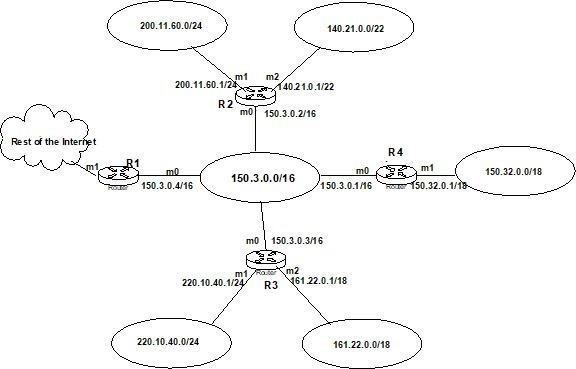COIT20261 Network Routing and Switching Assessment 2
COIT20261 Network Routing and Switching (Term 2, 2019)
Assignment item —Written Assessment-2
Objectives
This assessment task requires you to demonstrate your knowledge of routing concepts by completing a number of exercises. You will utilize material learned in the unit and also extend that learning through additional reading.
The assignment is designed to help you to achieve the unit learning outcomes as listed in the unit profile.
Instructions
You must do this assignment on your own – it is not a group assignment.
Type all your answers in the separate ‘Answer Template – Assgt TWO’ doc that you can download from the unit website, and submit only the completed template. Answers that are not typed into the Answer Template may not be marked, or may be returned to you for retyping and re-submission and late penalties will apply.
You can download the Answer Template – Assgt TWO doc from the Written Assignment 2 assessment link OR from the link in the Unit Documents section.
Where instructed, you must show the steps you took to arrive at your answers. Write your answers in your own words to avoid potential plagiarism and copyright violations.
You must submit the Answer Template in its original Word file (.doc or .docx) format. Do not submit PDF’s or any other type of file without express permission from the Unit Coordinator.
Plagiarism Procedures can be found in the CQUniversity Policies section of the Unit Profile.
Assessment Requirements and Marking Criteria
There are 3 main questions with sub-questions and the requirements are stated for each one. You must answer all questions and sub-questions if any. Marks are indicated and also shown in the Answer Template.
Marking criteria: Your answers will be marked based on technical correctness, completeness, clarity and relevance. Questions that ask you to show your working or calculations or the steps you took to arrive at your answers, may have marks deducted if such information is not provided.
The Assignment Questions begin on the next page.
REMEMBER, USE THE PROVIDED ANSWER TEMPLATE FOR ALL YOUR
ANSWERS. THE ANSWER TEMPLATE IS AVAILABLE FROM THE WEBSITE Question 1 – Routing Table construction (10 marks)
Given the following network diagram, assume that all the networks shown are aware of each other and have fully updated routing tables, and that the Default router’s interface m0 is configured with an IP of 150.3.0.4/16. Construct the routing table for routers R1 and R4.
List masks in longest mask order, and in CIDR format only

Question 2 – Forwarding process – classless addressing (5 marks)
This question relates to the forwarding process with classless addressing. You need to first understand the forwarding process as explained in Forouzan Chapter 6, Section 6.2. Assignment section 6.2 carefully, and then answer the following questions.
- Regarding a router determining whether a destination network is in its routing table or not, summarize in your own words the main difference in how a router treats a classful address versus a classless address. (1 mark)
- Refer to Figure 1 network diagram from question 1. Assume that a packet arrives at R3 with a destination address of 11.60.120. Show the router’s forwarding process, that is, all the calculations it does to determine where to send the packet, the results at each step, and the router’s decision at the end. Optionally, use a table to organize your data (2 marks).
- In the same diagram (Figure 1), assume that a packet arrives at R3 with a destination address of 32.203.10. Show the router’s forwarding process, that is, all the calculations it does to determine where to send the packet, the results at each step, and the routers decision at the end. Optionally, use a table to organize your data (2 marks).
Question 3 – Congestion controls in TCP (10 marks)
This question gives you the opportunity to extend your thinking about congestion controls in TCP beyond the textbook to consider alternative controls that real-world companies are using.
Instructions for Q.3
Read the following two articles about a different approach to improving congestion controls in TCP:
Article #1
https://www.networkworld.com/article/3218084/lan-wan/how-google-is-speeding-up-theinternet.html?idg_eid=f32fc7aec843db7ef67d0a4f08e3322d&email_SHA1_lc=&cid=nww_nlt_netwo rkworld_daily_news_alert_2017-08-22&utm_source=Sailthru&utm_medium=email&utm_campaign=NWW%20Daily%20AM%20Alert%2 02017-08-22&utm_term=networkworld_daily_news_alert
Article #2
https://tools.ietf.org/id/draft-cardwell-iccrg-bbr-congestion-control-00.html
After reading both articles, answer the following questions:
- Write a brief summary of the congestion controls in TCP discussed by Forouzan in this Unit (1 mark)
- Identify and explain two problems with current congestion controls in TCP that are pointed out in the articles (2 marks)
- Summarize in your own words the difference(s) between the current TCP congestion controls and the newer BBR protocol (3 marks)
- One article points out that it is difficult to get a new protocol accepted as a global standard for TCP/IP. Why do you think this is the case? Give carefully thought out reasons for your answer. (4 marks)
Important: Correct referencing conventions must be used throughout your work using the Harvard referencing convention. Your answers will be marked on clarity, logic, relevance, use of own words and fully addressing all parts of each question. You must use your own words and must not copy text from the textbook without attribution, or from any other source.
Remember that quotations alone will not be accepted as your explanation of the questions.
Quotations can support your explanations, but you must still provide the explanations yourself. Best way forward is to keep direct quotations to a minimum, and use your own words.


